Do you often find yourself lying awake in bed praying for sleep? If so, you’re not alone—one out of three adults in the US has had recent sleep problems, with around one in ten meeting full criteria for insomnia. Persistent problems with sleep are not just frustrating but also can affect our mental and physical health.
When I first started out to become a psychologist I focused on treating depression, anxiety, OCD, and PTSD. What I discovered was that so many of the men and women I treated also struggled to get a good night’s sleep, and their sleep problems often continued even after they’d found relief from their other symptoms.
I realized I needed additional tools to treat the insomnia and started researching the best psychological treatments for poor sleep, which led me to cognitive behavioral therapy for insomnia (CBT-I). As I completed advanced training in CBT-I, I learned why it’s the first-line treatment for chronic difficulty falling asleep or staying asleep. After around 4-6 sessions, most people who get CBT-I are able to fall asleep more quickly and sleep more soundly. The improvements typically last, too, with total sleep time actually increasing after treatment has ended.
Finding CBT-I
If this is sounding too good to be true, there may be a catch: Depending on where you live, you may not be able to find a therapist who provides CBT-I. Many people in the US and other parts of the world live hours from the nearest CBT-I provider.
One possible solution if there are no CBT-I therapists near you is CBT-I by teleconference, which can make the treatment much more accessible. Recent research, like a study completed at my local VA hospital, shows that CBT-I can be effective when delivered remotely.
 I’ve provided CBT for many conditions by video conference and find that CBT-I is probably the best match for this form of treatment delivery. It tends to be straightforward and data-driven, and the results I’ve gotten are about the same as those for in-office treatment.
I’ve provided CBT for many conditions by video conference and find that CBT-I is probably the best match for this form of treatment delivery. It tends to be straightforward and data-driven, and the results I’ve gotten are about the same as those for in-office treatment.
This option is not a fix-all, of course, because most clinicians do not provide therapy by phone or video, and there are restrictions on practicing across state lines if the therapist is not licensed in the state where the patient lives.
Can I Afford It?
If you do live near a world-class sleep centers or have access to CBT-I by video conference, there’s still the issue of paying for it. Many CBT-I therapists are out-of-network providers, meaning they don’t participate directly in insurance networks.
A course of CBT-I can cost as much as a couple thousand dollars, which you’d be paying out of pocket. In the best case scenario you could get a percentage of the cost back from your insurance carrier, often after a good bit of time and hassle.
Thankfully there’s reason to be hopeful even if you don’t have access to a CBT-I therapist for one reason or another. The specifics of CBT-I make it a good fit for self-guided treatment: It relies on a few basic principles, and it’s easy to tell if it’s helping.
CBT-I also doesn’t tend to rely on a close emotional connection to a caring provider, and usually doesn’t involve deep discussions about one’s childhood or other complex issues. And while self-help CBT-I on average is less effective than therapist-led CBT-I, it nonetheless can provide considerable relief.
I’ve reviewed the principles of CBT-I in a previous post on my Psychology Today blog; the main components are:
- determining the optimal amount of time to spend in bed
- keeping a consistent bedtime and wakeup time
- using the bed only for sleeping (and sex if applicable)
- getting out of bed if you’re not falling asleep
- addressing thoughts that interfere with sleep
- additional options like relaxation training as needed
These features can be delivered through online and mobile applications, as well as in self-help books. Both of these approaches offer advantages over in-person treatment, and not just in terms of cost. The treatment can be done very flexibly on one’s own, which avoids having to schedule around work or other commitments. There is also no travel time involved, which further eliminates practical barriers to the treatment.
Let’s take a look at some of the available apps and websites first. (Disclaimer: I have no financial incentive to promote any of these products.)
Digital CBT-I
Several studies have confirmed that computerized CBT-I can be effective (like this review and this one). There are several apps on the market; below I review some of the better tested ones.
Sleepio
Jennifer Cowie and her colleagues at the Sleep and Anxiety Center of Houston conducted a”multimedia field test” that focused primarily on Sleepio, which is available online and as a mobile app.
Sleepio includes videos on the rationale for CBT-I, which is important because some parts of CBT-I are counterintuitive or just plain difficult. Getting a solid explanation up front can improve follow-through. These videos cover topics like sleep scheduling, relaxation techniques, mindfulness, and a winding down routine.
Sleepio also makes it easy to keep a log of nightly sleep (e.g., bedtime, length of time to fall asleep), and these numbers are essential for figuring out how to adjust sleep behaviors. Users can see their progress over time, which can increase their motivation to stick with the program.
Does it work? In the largest study to date, Sleepio led to effects comparable to those of CBT-I with a therapist:
- a 20% increase in sleep efficiency (sleep time divided by time spent in bed; e.g., sleeping 6 hours while being in bed for 10 would be a 60% sleep efficiency)
- a 26 minute decrease in time to fall asleep
- a 48 minute decrease in time awake in the middle of the night
- average insomnia scores in the healthy range
- better energy, mood, and productivity
Sleepio and similar programs are not recommended for some individuals, such as those who have an unstable medical or psychiatric condition. Sleepio is available for iOS only and has one of the highest price tags among CBT-I apps—$300 for a 1-year period. That said, just the initial evaluation with a CBT-I specialist could easily cost $300. In the big picture, $300 is probably a lot less than the cost of untreated insomnia (both in terms of dollars and personal misery).
Sleep Reset
Sleep Reset is a personalized sleep program grounded in science. A rigorous research study published in Frontiers in Sleep found that it increases sleep time among short sleepers by an average of almost an hour and a half; it also cuts the time to fall asleep and the number of night awakenings by about 50%. Sleep Reset gets very strong reviews—4.8 based on 1300 ratings—on the iOS App Store.
The Sleep Reset program comes with a dedicated sleep coach who tailors the program just for you based on an in-depth assessment, and aims to address the underlying cause of your sleep difficulties. The app includes:
- exercises to shift unhelpful thinking patterns
- behavior change techniques to promote sound sleep
- relaxation training
- sleep hygiene
- sleep log and progress tracking
Sleep Reset offers a pick-your-price introductory week; the full 8-week program is currently $297.
SHUT-i (Sleep Healthy Using the Internet)
The best-validated digitized CBT-I program is not an app but rather is available through the Internet. The SHUT-i website details the studies that support it, including strong follow-up data a full year after treatment has ended.
SHUT-i is designed to maximize engagement, so its lessons tend to be interactive (e.g., quizzes) rather than one-directional lecture videos. The program is 6 weeks long, and each week’s lesson takes about 45 minutes to complete. As with other digitized CBT programs, you’ll enter your sleep data so that SHUT-i can give you tailored sleep recommendations.
SHUT-i is on the pricier end: $149 for 6 months, or $215 for a year. But again, these numbers pale in comparison to the cost of persistent insomnia.
CBT-i Coach
The US Department of Veterans Affairs developed CBT-i Coach as a way to “augment face-to-face care with a healthcare professional,” so it’s not meant as a standalone treatment. On the plus side, it’s free, available for both iOS and Android systems, and offers an easy way to track nightly sleep and progress over time. If you’re doing CBT-I with a therapist, you might talk with him or her about supplementing that work with CBT-i Coach.
For those who’ve struggled with insomnia long enough, these kinds of apps could be an effective and relatively affordable way to fix bad sleep.
CBT-I Self-Help Books
If you prefer a lower tech self-help solution, there are some good books on CBT-I. Here are some of the ones I like. (Please note: The links below are affiliate links, meaning at no cost to you I earn a commission on clicks that lead to a purchase.)
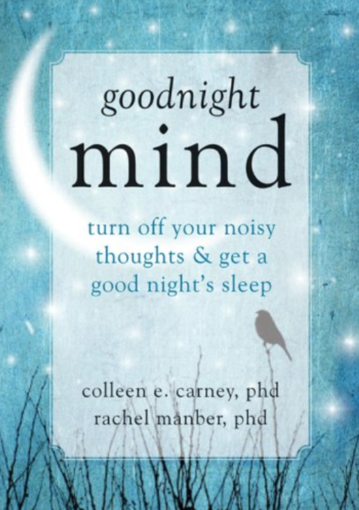 Goodnight Mind: Turn Off Your Noisy Thoughts and Get a Good Night’s Sleep (
Goodnight Mind: Turn Off Your Noisy Thoughts and Get a Good Night’s Sleep (
Carney and Manber begin their book by laying out the recipe for good sleep. The next two chapters tell you what behaviors to change in order to tighten up your sleep.
The rest of the book focuses on the “C” in CBT-I, emphasizing training the mind in order to sleep well. There are chapters on quieting an active mind, establishing a winding down routine at night, and relaxing the body (which can relax the mind), among others. Throughout these chapters the authors highlight the importance of letting go of effort, which is incompatible with sleep. (If you’re curious, try really hard to fall asleep tonight!)
The final chapter makes explicit what’s was implicit in earlier chapters: That mindful acceptance and letting go can help us step out of the struggle with sleepless nights—leading to better sleep. They encourage opening to your experience even if you’re unhappy about it, to avoid the trap of resisting what we cannot change.
You can choose to accept feelings of tiredness during the day, rather than giving in to those feelings and reducing your activity levels. —From Goodnight Mind
Goodnight Mind might be the book for you if your thoughts are the biggest enemy of your sleep.
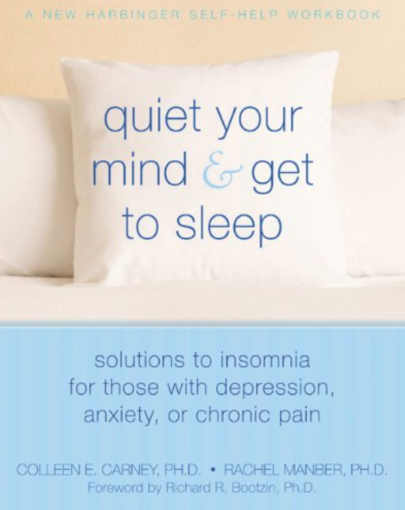 Quiet Your Mind and Get to Sleep: Solutions to Insomnia for Those with Depression, Anxiety, or Chronic Pain (Colleen Carney & Rachel Manber; 192 pages)
Quiet Your Mind and Get to Sleep: Solutions to Insomnia for Those with Depression, Anxiety, or Chronic Pain (Colleen Carney & Rachel Manber; 192 pages)
In their earlier collaboration on CBT-I, Carney and Manber start with an overview of sleep and insomnia, including how insomnia develops and what maintains it. Both of the authors are sleep experts, and it comes across in their writing. At the same time, I like how they break down the concepts into ideas that are easy to understand, and use clear diagrams to illustrate key points.
Later in the book they address common barriers to good sleep—what they call “sleep thieves”—and how CBT-I removes them. They also devote a chapter to the problem of anxiety about sleep which often creates a vicious circle that perpetuates insomnia.
A plus of this book is that the authors address the depression, anxiety, and chronic pain that often go along with chronic insomnia. They include descriptions of these other conditions so you can do a self-assessment, and discuss how medications can interact with insomnia.
The Resources section at the back contains book and web recommendations for further information about topics like depression, anxiety, chronic pain, and better relationship communication.
If you’re looking for an informative self-help insomnia book that addresses depression, anxiety, and chronic pain, Quiet Your Mind and Get to Sleep might be right for you.
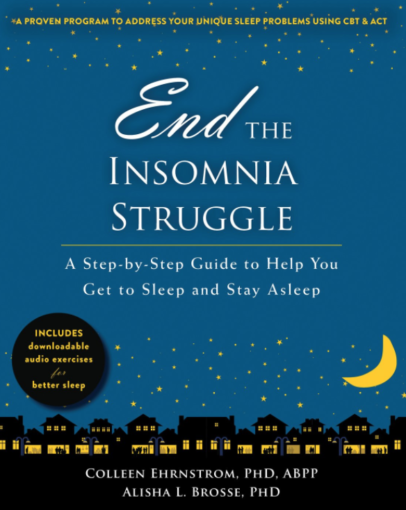 End the Insomnia Struggle: A Step-by-Step Guide to Help You Get to Sleep and Stay Asleep (Colleen Ehrnstrom & Alisha Brosse; 232 pages)
End the Insomnia Struggle: A Step-by-Step Guide to Help You Get to Sleep and Stay Asleep (Colleen Ehrnstrom & Alisha Brosse; 232 pages)
This book is divided into 4 sections:
- an introduction to sleep and insomnia, including the principles of mindfulness that can be powerful antidotes to insomnia
- behavioral strategies—the “B” in CBT-I—including sleep scheduling and building a strong association between Bed and Sleep
- cognitive strategies—the “C” in CBT-I—including changing unhelpful thoughts, dealing with worry, and the practice of mindfulness
- maintaining and building on your treatment progress
At the end of the book the authors include sections on circadian rhythm disorders (like being stuck at a 4 AM bedtime and a 12:00 noon wakeup time) and menopause. The incorporation of mindfulness-based approaches is a further strength of this book; I find in my own practice (not to mention in my own life) that sleep-related acceptance is an invaluable tool in managing insomnia.
Ehrnstrom and Brosse write in a warm and inviting style that seems to embody the principles of mindfulness that they describe. It strikes me as the best type of compassion: empathic and understanding while also encouraging the changes that will relieve suffering long-term. They’re good guides for this journey.
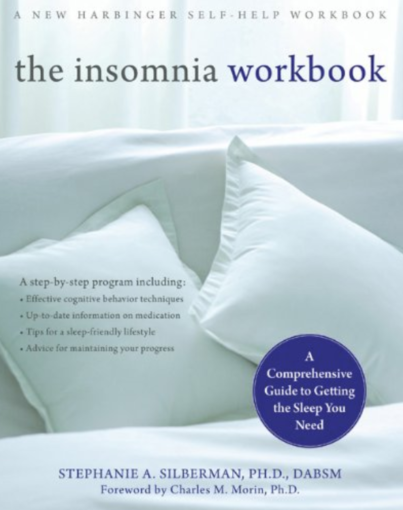 The Insomnia Workbook (Stephanie Silberman; 224 pages)
The Insomnia Workbook (Stephanie Silberman; 224 pages)
This workbook starts out in the usual way—an overview of sleep followed by a discussion of what insomnia is. Silberman then devotes an entire chapter to sleep medication, followed by chapters that cover the components of CBT-I (e.g., sleep hygiene, relaxation techniques, cognitive techniques).
Silberman’s writing is pretty technical at times, so if you’re interested in the nitty gritty of the sleep cycle, for example, you’ll appreciate her discussion of sleep spindles and K-complexes. She also addresses interesting and important changes in sleep across the lifespan, including the effects of becoming a parent on sleep (spoiler: having a baby usually doesn’t improve sleep), as well as parasomnias (e.g., sleep walking) and stress management.
The book also includes many case examples that illustrate the principles, as well as worksheets that make it live up to its name as a workbook. Silberman’s final chapter addresses sleep issues specific to women (who are more likely to have insomnia), like hormonal changes and pregnancy. Her Resources section includes a few helpful websites and relaxation exercises, but is not as substantial as that of Quiet Your Mind and Get to Sleep.
For readers interested in a meaty and straightforward approach to CBT-I, including issues specifically targeted toward women, this workbook could be right up your alley.
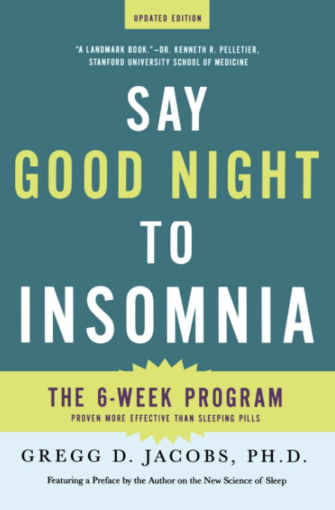 Say Goodnight to Insomnia (Gregg D. Jacobs; 256 pages)
Say Goodnight to Insomnia (Gregg D. Jacobs; 256 pages)
This book was one of the earliest self-help CBT-I guides, first published in 1998. Jacobs divides his book into three parts. The first addresses the basics of sleep and insomnia: the sleep cycle, the purpose of sleep, changes in sleep as we age, and types of insomnia.
He also spends a full chapter on how to get off sleep medication—an important topic since many people find themselves on medication that isn’t really helping but is hard to stop because of the temporary rebound insomnia. It’s also a topic Jacobs is imminently qualified to write about, as he conducted a large research trial at Harvard that showed that CBT-I was better than Ambien in the treatment of insomnia.
Part II is the nuts and bolts of CBT-I, and leads you through the mental and behavioral changes that will improve your sleep. The final section is on managing stress, including chapters on relaxation, cognitive techniques, and developing attitudes that reduce stress and promote sleep.
The program Jacobs presents is meant to be completed in 6 weeks, and includes plenty of case examples. Jacobs writes as one who knows his stuff, having the confidence that comes from extensive research and clinical experience with CBT-I. He knows it works because he’s seen it work countless times, and his confidence can support your work through the 6-week program.
Choosing Among Various Options
As you’re considering these different titles, look for one that resonates with you and your needs. Just like when we’re looking for a therapist, the fit is crucial. None of the books had unanimously positive reviews, but many people liked and benefited from each of them. The better you feel about the book’s approach and the authors’ tone, the greater the odds that you’ll complete the treatment and the better your chances of improved sleep.
Does self-help CBT-I, whether in digital or book form, help everyone with insomnia? Certainly not, just as therapist-delivered CBT-I (or sleep medication) helps most people but not everyone. If you don’t find relief with a self-directed approach, consider working with a therapist if at all possible.
It may also be necessary to address issues that can perpetuate poor sleep such as anxiety, physical pain, or chronic stress. I’ve treated people who had gotten CBT-I before but were still struggling with poor sleep. Sometimes it’s mostly a matter of following the treatment guidelines more closely, whereas at other times there were additional issues that we needed to address before their sleep could improve.
If you’ve had insomnia for any length of time, I’d be willing to bet you’ve tried just about everything to fix your sleep: making your room a sleep sanctuary, limiting screen time at night, putting lavender on your pillow, certain types of herbal tea before bed, a warm bath, exercise, etc. etc. etc.
At some point many people lose hope that anything can fix their sleep. If you’ve started to despair of ever sleeping better and haven’t tried CBT-I, I encourage you to give it a chance. You don’t have to convince yourself it’s going to work in order to give it a fair shot—just bring your skepticism and your willingness to see how it works for you. Chances are you’ll be among the vast majority of people whose sleep gets better and stays better with CBT-I.
